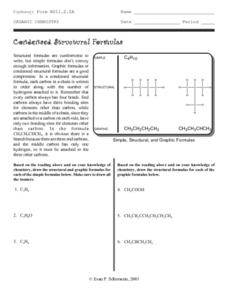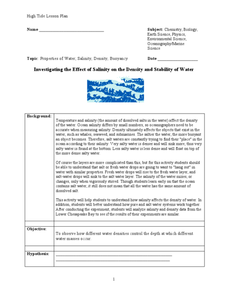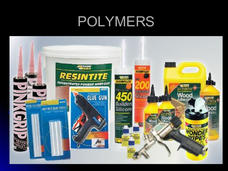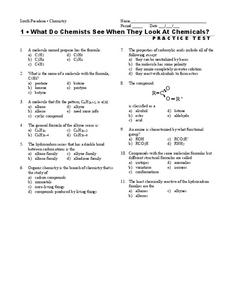Curated OER
Chemistry: Section Review
Review the 5 branches of chemistry and related terms with this worksheet. The focus of these activities is on terms and definitions. Learners answer questions about the study of chemistry, reasons to study chemistry, and pure and applied...
Curated OER
Organic Chemistry Practice Test
Framed as an organic chemistry practice test, this resource could be used for a variety of purposes. Composed of 15 questions about organic compounds such as isomers, alkynes, alkenes and amines, and other topics related to organic...
Curated OER
Honors Chemistry, Organic Chemistry
Looking for a versatile worksheet on organic chemistry? If so, you might consider this resource. This resource asks learners to identify organic molecules, match terms with their definitions, determine bond angles and hybridization of...
Curated OER
The Influence of Carbon Dioxide on the Chemistry of Soda
High schoolers investigate the carbon dioxide content of different sodas. In this chemistry lesson plan, students explain why PET containers are preferable than HDPE for soda bottles. They collect data and graph them.
Curated OER
Introduction to AP Chemistry
High schoolers are introduced to concepts in an AP Chemistry class. They work together to complete experiments on different materials. They discuss the results of the experiments.
Curated OER
Branches of Science Lesson Plans
Teachers can use branches of science lesson plans to get students excited about science careers.
Curated OER
Alkane Nomenclature Worksheet
This activity asks learners to work on alkane nomenclature. They name 2 straight-chain alkanes and answer 4 questions about branched-chain alkanes. In addition, class members name 5 branched-chain alkanes and draw the structures for 3...
Curated OER
Amazing Carbon
Explore carbon and bonding with this instructional activity. First, class members read a short excerpt about carbon and its characteristics. In response to the reading, they draw an electron dot diagram of carbon as well as diagrams of...
Curated OER
Bouncing Balls
Students create a polymer ball in the lab. In this chemistry lesson plan, students identify the different properties of the polymer they created. They explain what type of chemical reaction took place.
Curated OER
Organic Chemistry-Condensed Structural Formulas
For this structural formulas worksheet, learners are given three condensed structural formulas and three non-condensed structural formulas. They draw the structural and graphic formulas for each compound.
Mr. Jones's Science Class
Periodic Table Project
Don't be fooled by the title; this is not really a lesson on elements. It is a project on classification, using the periodic table as an example. For that reason, it could be used in any branch of science. As an example, a group may...
Curated OER
Investigating the Effect of Salinity on the Density and Stability of Water
Water with varying amounts of dissolved salt are dyed and then used to compare densities. The objective is to discover the effect of salinity, and therefore density, on ocean water on the stability of the ocean. Many branches of science...
Curated OER
Polymers
Present polymers to your chemistry class with this practical PowerPoint. Begin with a definition and the properties of polymer materials. Branch out into diagrams of polymer structure. Consider the two general types: addition polymers...
Curated OER
Evolutionary Relationships Based Upon Comparative Genetics
Young scholars investigate the protein cytochrome c in an attempt to use its genetic chemistry to study possible evolutionary relationships between organisms. The lesson integrates technology with the use computers to perform DNA analysis.
Curated OER
Naming Alkanes
In this chemistry worksheet, students name each of the branched alkanes presented on the sheet. Then they draw the structural formulas for the molecules.
Curated OER
Explorit's Coffee, Tea or Chocolate Quiz
In this coffee and tea activity, students complete a six question multiple choice on-line interactive quiz about the cultivation and chemistry of coffee, tea and chocolate.
Science Geek
Basic Biochemistry - Carbohydrate, Protein and Fat
You are what you eat, right down to your molecular structure. A hearty presentation begins with the two types of carbohydrates, simple and complex. Then it details proteins and amino acids. It ends by reviewing the three types of...
National Institute of Open Schooling
Nomenclature and General Principles
Carbon, the base for all organic compounds, exists in nature in its purest form as graphite or diamonds. The 25th lesson in a series of 36 teaches pupils the nomenclature of organic compounds. Learners read about how to use the IUPAC...
Curated OER
Chemical Compounds
In this chemical compounds worksheet, students match the chemical formula with its chemical structure. This worksheet has 39 matching questions.
Creative Chemistry
Alkanes: Physical Properties
For this alkanes worksheet, students complete a graphic organizer by filling in the number of carbon atoms for the given alkanes. Students plot a graph showing how physical properties change with the number of carbon atoms. Then,...
Curated OER
Organic Compounds
In this organic compounds learning exercise, students practice identifying chemical structures and compare sugars, starches, and lipids. This learning exercise has 5 matching and 15 multiple choice questions.
Curated OER
What do Chemists See When they Look at Chemicals?
In this chemicals worksheet, students answer 15 multiple choice questions about chemicals, compounds, inorganic and organic molecules.
Newspaper Association of America
Cereal Bowl Science and Other Investigations with the Newspaper
What do cereal, fog, and space shuttles have to do with newspapers? A collection of science investigations encourage critical thinking using connections to the various parts of the newspaper. Activities range from building origami seed...
Cornell University
Splitting Water with Electricity
Explore how electricity splits water molecules into hydrogen and oxygen. Learners begin by calculating the voltage necessary to separate the water. They then perform the experiment and measure the ratio of hydrogen and oxygen bubbles.

























